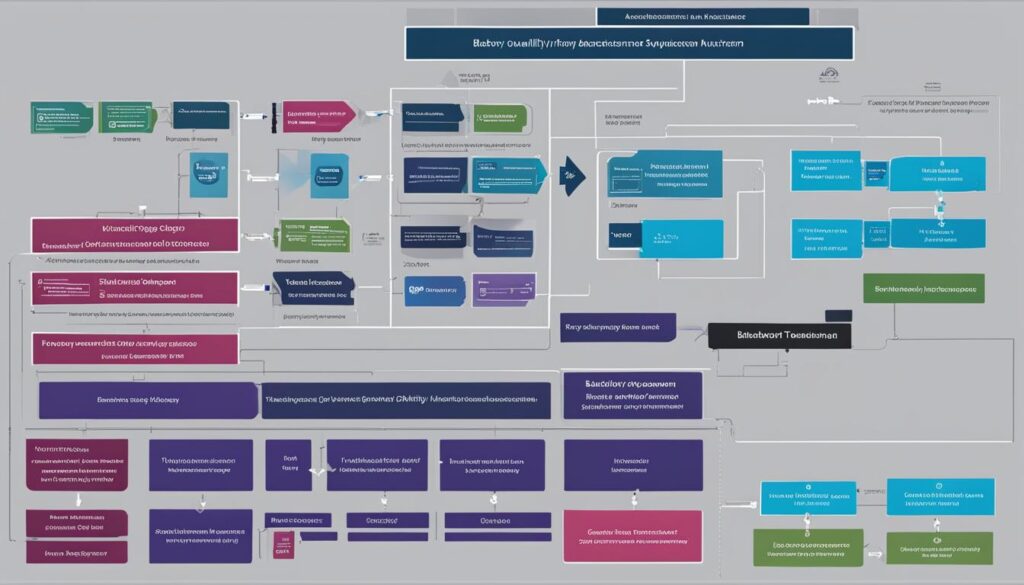Welcome to our article on BlackBerry’s IT architecture. In this comprehensive guide, we will explore the intricacies of BlackBerry’s technology framework, specifically focusing on the enterprise architecture that forms the backbone of their secure connectivity and efficient information management solutions.
BlackBerry’s IT architecture encompasses a wide range of components, including hardware, software, and robust security measures. It has evolved over time, building upon BlackBerry’s early innovations in the pager and wireless network industry. Today, it leverages the power of Java programming language, virtual machines, cryptography, and security protocols to provide state-of-the-art IT solutions for enterprises.
Contents
- 1 Evolution of BlackBerry Architecture
- 2 Benefits of Java on a Mobile Device
- 3 BlackBerry API Evolution
- 4 BlackBerry Architecture Branches
- 5 Conclusion
- 6 FAQ
- 6.1 What is BlackBerry IT architecture?
- 6.2 How has BlackBerry’s architecture evolved over time?
- 6.3 What are the benefits of Java on a mobile device like BlackBerry?
- 6.4 How has BlackBerry’s API evolved over time?
- 6.5 How does BlackBerry ensure the quality of its solutions?
- 6.6 Does BlackBerry have different architecture branches?
- 6.7 What are the key features of BlackBerry’s IT architecture?
- 7 Source Links
Key Takeaways:
- BlackBerry’s IT architecture is a comprehensive framework that enables secure connectivity and efficient information management.
- The architecture has evolved from BlackBerry’s early innovations in the pager and wireless network industry.
- Java programming language, virtual machines, cryptography, and security protocols are key elements of BlackBerry’s IT architecture.
- The architecture supports enterprise-level solutions for secure connectivity and optimized information management.
- BlackBerry’s IT architecture has been developed to meet the evolving needs of enterprises and address security concerns.
Evolution of BlackBerry Architecture
The evolution of BlackBerry’s architecture can be traced back to the early days of Research in Motion (RIM), the company behind BlackBerry. RIM, an engineering firm founded in the 1980s, eventually ventured into the pager and wireless network industry, paving the way for the development of BlackBerry technology.
In 1999, RIM made a significant breakthrough with the launch of its first BlackBerry device. This device, which was Java-based, introduced the power of the Java programming language to the world of mobile devices. It revolutionized the way people communicated and utilized wireless technology on the go.
These early BlackBerry devices operated on limited hardware capabilities, running on a single AA battery and featuring a restricted amount of memory. Despite these limitations, they laid the foundation for the advancement of BlackBerry devices in the future.
The Impact of Java on BlackBerry Devices
“By introducing Java programming language to BlackBerry devices, RIM unleashed a wave of possibilities for mobile communication and productivity,” says John Chen, CEO of BlackBerry.
The integration of Java on BlackBerry devices brought numerous advantages and unlocked new potentials. First and foremost, it allowed developers to harness the power of the Java Virtual Machine (JVM). This dynamic runtime environment enabled the separation of application code from the device’s radio code, consequently enhancing security and mitigating potential vulnerabilities.
Moreover, Java’s standardized language and runtime environment made it easier for developers to create innovative applications for BlackBerry devices. It provided a familiar and consistent platform, allowing developers to leverage their existing Java knowledge and skills.
Another key benefit of Java on BlackBerry devices was the smaller code size compared to other programming languages like C++. This optimization of code contributed to the efficient use of limited resources, ensuring smooth performance and user experience.
To highlight the impact of Java on early BlackBerry devices, let’s explore their hardware limitations. These devices ran on a single AA battery, but despite their size, they were able to deliver impressive functionality. The limited memory capacity posed a challenge, but through strategic hardware and software optimization, BlackBerry devices were still able to offer reliable and secure mobile communication solutions.
| Device Model | Battery Life | Memory Capacity |
|---|---|---|
| BlackBerry 850 | Approx. 3 days | 2 MB Flash Memory |
| BlackBerry 950 | Approx. 3 days | 4 MB Flash Memory |
| BlackBerry 957 | Approx. 2 days | 10 MB Flash Memory |
These early BlackBerry devices, with their limited hardware capabilities, revolutionized the mobile communication landscape. The seamless integration of Java programming language and optimized hardware design set the stage for the future development of more advanced BlackBerry devices.
Continuing their commitment to innovation and secure connectivity, BlackBerry has come a long way since the early days of RIM. Today, their architecture incorporates cutting-edge technologies to provide comprehensive solutions for enterprises to manage and secure their information effectively. The history of BlackBerry showcases their dedication to transforming the mobile communication industry and driving technological advancements.
Benefits of Java on a Mobile Device
Transitioning from the C++ programming language to Java on BlackBerry devices brought numerous benefits that enhanced the development and performance of applications. The utilization of the Java Virtual Machine (JVM) played a crucial role in achieving these advantages.
The Java Virtual Machine allowed for the isolation of application code from the device’s radio code, resulting in enhanced security measures. By separating these components, potential security risks, errors, and unauthorized access were effectively prevented. This isolation created a robust framework that protected sensitive data and ensured a secure application environment.
Another advantage of Java on BlackBerry devices was the standardized language and runtime environment. Developers found it easier to write applications for BlackBerry devices using Java due to its consistent syntax and comprehensive libraries. This standardization facilitated quicker development and reduced the potential for errors.
The use of Java also contributed to a smaller code size, enabling efficient usage of limited resources in early BlackBerry devices. Java bytecode, the compiled form of Java source code, tends to be more compact compared to the code written in C++. This reduction in code size resulted in lighter applications that optimized system performance and responsiveness.
Moreover, the Java bytecode verification process ensured the correctness and integrity of the application code, which was crucial for maintaining security on BlackBerry devices. Bytecode verification added an extra layer of protection by examining every instruction executed by the Java Virtual Machine, verifying that it adheres to the specified rules and constraints.
“The Java Virtual Machine provided a secure and efficient environment for application development on BlackBerry devices. By isolating the application code and employing bytecode verification, developers could create robust and secure applications. Additionally, the smaller code size achieved through Java contributed to optimized resource usage.”
Advantages of Java on BlackBerry Devices:
- Enhanced security through the isolation of application code from the device’s radio code
- Easier application development with a standardized language and runtime environment
- Optimized usage of limited resources with smaller code size
- Ensured correctness and integrity of application code through bytecode verification
Overall, Java on BlackBerry devices provided a secure and efficient platform for application development. The combination of the Java Virtual Machine, secure application development practices, bytecode verification, and smaller code size contributed to the reliable and high-performance experience of BlackBerry applications.
| Advantages of Java on Mobile Devices |
|---|
| Enhanced security through the isolation of application code |
| Easier development with standardized language and runtime environment |
| Optimized resource usage with smaller code size |
| Ensured correctness and integrity of application code through bytecode verification |

BlackBerry API Evolution
BlackBerry’s API evolution has been guided by the Java Community Process (JCP), a community-driven effort for the development of Java standards and specifications. This evolution has resulted in the release of various Java Specification Requests (JSRs) that have expanded the functionality and capabilities of BlackBerry devices. Some notable JSRs include support for wireless messaging, Bluetooth, secure communication, and security and trust services. These APIs have been crucial in enabling developers to create innovative and secure applications for BlackBerry devices.
One of the key areas of focus in the BlackBerry API evolution has been the integration of wireless messaging capabilities into the platform. This integration allows developers to leverage the power of wireless connectivity to create engaging and real-time communication experiences for users. With the BlackBerry platform’s robust wireless messaging API, developers can implement features such as push notifications, instant messaging, and email integration, enhancing the overall user experience.
In addition to wireless messaging, BlackBerry’s APIs also offer extensive support for security and trust services. With built-in encryption, authentication, and authorization capabilities, developers can ensure the confidentiality and integrity of data exchanged between BlackBerry devices and backend systems. This level of security is especially crucial for applications handling sensitive information, such as financial transactions or healthcare data.
To further enhance the functionality of BlackBerry devices, the API evolution has also introduced support for Bluetooth technology. This enables developers to create applications that can communicate and interact with a wide range of Bluetooth-enabled devices, such as speakers, headphones, and IoT devices. The seamless integration of Bluetooth APIs into the BlackBerry platform allows for a seamless and intuitive user experience.
Overall, the BlackBerry API evolution has played a significant role in shaping the capabilities and possibilities of BlackBerry devices. Developers can leverage these APIs to build feature-rich, secure, and innovative applications that enhance productivity and user engagement. By continuously expanding the functionality of its APIs, BlackBerry ensures that its platform remains at the forefront of mobile technology, providing developers with the tools they need to create cutting-edge applications.
| Java Specification Requests (JSRs) | Key Features |
|---|---|
| JSR 120 | Wireless Messaging API |
| JSR 82 | Bluetooth API |
| JSR 177 | Security and Trust Services API |

| Quality Assurance Practices | Benefits |
|---|---|
| Code reviews | Identification of flaws Vulnerability assessment |
| Beta testing | Real-world usage feedback Refinement of products |
| Early access programs | External testing and feedback Collaborative development |
| Testing streams | Prompt issue identification and resolution Continuous improvement |
BlackBerry Architecture Branches
BlackBerry’s architecture is designed to support long-term software development efforts. As devices and technology evolve, new hardware capabilities become available, necessitating the creation of specific branches to support different carriers and their network requirements.
This branch model allows carriers to maintain control over their code and ensure compatibility with their networks. By having specific carrier branches, BlackBerry can tailor its solutions to meet the unique needs of each carrier and provide optimal performance. This approach ensures that BlackBerry devices work seamlessly with different network technologies and protocols.
Standard Branch Model
BlackBerry follows a standard branch model to manage its software development process. This model involves a main branch that serves as the baseline for the entire development process. Developers work on feature branches where they implement new functionalities or fix issues. These changes are then merged into the main branch through a controlled process, ensuring stability and quality.
The standard branch model allows for parallel development of multiple features and bug fixes without disrupting the overall development process. It facilitates collaboration among developers and streamlines the integration of new features into the main branch.
Quality by Process
Quality is a top priority in BlackBerry’s development approach. The company emphasizes quality at every stage of the software development lifecycle. Formal design documents provide a clear understanding of the requirements and goals of each project.
Code reviews are conducted to ensure code quality and identify any potential issues or vulnerabilities. Thorough testing, including unit testing, integration testing, and system testing, is performed to validate the software’s functionality and performance. BlackBerry also engages in beta testing and early access programs, allowing users and partners to provide feedback and improve the overall quality of the software.
Adherence to standardized processes and best practices ensures consistency and reliability across BlackBerry’s architecture. It minimizes the risk of errors, enhances security, and maximizes the performance of BlackBerry devices and solutions.
Overall, BlackBerry’s architecture branches, combined with a rigorous quality assurance process, contribute to the long-term success of its software development efforts. These practices enable BlackBerry to deliver high-quality, reliable, and secure solutions that meet the evolving needs of carriers and customers.

Conclusion
BlackBerry’s comprehensive IT architecture is designed to provide enterprises with secure connectivity and efficient information management. Evolving from its early innovations in the pager and wireless network industry, BlackBerry’s IT architecture has embraced the power of Java programming language, bringing enhanced security, easier application development, and smaller code size.
The continued evolution of BlackBerry’s APIs, coupled with rigorous quality assurance practices and a flexible branch model, ensures the reliability and performance of its solutions. With a focus on long-term software development and tailored branches for specific carriers, BlackBerry maintains compatibility with diverse network requirements.
Overall, BlackBerry’s IT architecture offers a comprehensive framework that meets the evolving needs of enterprises. With its commitment to secure connectivity and efficient information management, BlackBerry continues to empower businesses to thrive in today’s digital landscape.
FAQ
What is BlackBerry IT architecture?
BlackBerry IT architecture refers to the comprehensive framework that enables secure connectivity and efficient information management for enterprises using BlackBerry technology solutions.
How has BlackBerry’s architecture evolved over time?
BlackBerry’s architecture has evolved from its early innovations in the pager and wireless network industry to encompass the use of Java programming language, virtual machines, cryptography, and security protocols to provide robust IT solutions for enterprises.
What are the benefits of Java on a mobile device like BlackBerry?
The use of Java on BlackBerry devices allows for enhanced security, easier application development, and smaller code size. It also enables the isolation of application code from the device’s radio code and ensures bytecode correctness through verification processes.
How has BlackBerry’s API evolved over time?
BlackBerry’s API has evolved through the release of various Java Specification Requests (JSRs) that have expanded the functionality and capabilities of BlackBerry devices. These JSRs have introduced support for wireless messaging, Bluetooth, secure communication, and security and trust services.
How does BlackBerry ensure the quality of its solutions?
BlackBerry ensures quality through rigorous code reviews, beta testing with real-world usage and user feedback, and early access programs that allow partners and developers to contribute to the testing and refinement process. Testing streams are also used to identify and address issues promptly.
Does BlackBerry have different architecture branches?
Yes, BlackBerry maintains different branches to support different carriers and their network requirements. This branch model allows carriers to maintain control over their code and ensure compatibility with their networks.
What are the key features of BlackBerry’s IT architecture?
BlackBerry’s IT architecture provides a comprehensive framework for secure connectivity and efficient information management. It incorporates hardware, software, security measures, and a standardized development process to deliver reliable and robust IT solutions for enterprises.
Source Links
- https://cs.uwaterloo.ca/~a78khan/courses-offered/cs446/2010_05/lecture-slides/BB_Architecture.pdf
- https://www.zsis.hr/UserDocsImages/Sigurnost/pdfs/BlackBerry_Enterprise_Solution.pdf
- https://www.darkreading.com/endpoint-security/blackberry-delivers-zero-trust-architecture-through-blackberry-spark-platform




